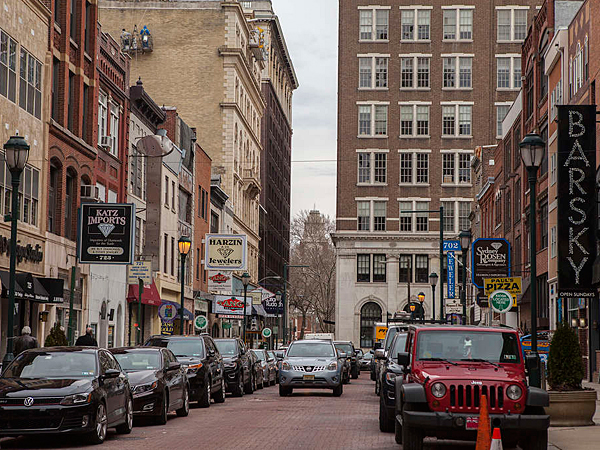
Alexander Danta curled his frame around a cluttered wooden table in his Jewelers' Row workshop to inspect his latest handiwork, a diamond-and-ruby wedding band that nested in his meaty palm like a newborn chick. Raising the delicate ring to the window, he tipped it slightly to catch the light, revealing an acanthus vine he had just etched on the side, perhaps a centimeter wide and sharp as a line of type.
Danta is a master engraver, among the last in Philadelphia to work exclusively with hand tools, and his studio was the custom-made ring's latest stop on its journey through the Jewelry Trades Building at Eighth and Sansom Streets, a six-story beehive filled with designers, casters, polishers, and stone-setters. Once he finished his contribution to the making of the ring, it would be delivered to the next workshop, where a plater would coat the white gold in platinum.
Most of us know Philadelphia's jewelry district for its glittering and sometimes gaudy stores selling everything from chunky gold watches to diamond-encrusted wedding fare. But it's also what people nowadays like to call a "makers space."
Maybe because working factories have virtually vanished from the urban landscape, we rarely think of Philadelphia - never mind Center City - as a place where stuff gets made. Yet, right in the shadow of Washington Square's pricey high-rise condos, dozens of workshops such as Danta's have somehow managed to survive on the upper floors of historic Jewelers' Row.
That doesn't mean they will be there forever.
Packed tightly into the two city blocks between Walnut and Chestnut, from Seventh to Eighth, the jewelry district is a rare survivor from Philadelphia's heyday as the self-proclaimed "workshop of the world."
The city was once full of such niche districts: fabric on Fourth Street, restaurant supply on Second Street, produce on Dock Street, beer in Northern Liberties. Those businesses clustered together because they relied on one another's services. But modern innovations such as websites and overnight delivery have made such physical proximity unnecessary. One by one, businesses dispersed, often to the suburbs.
Jewelers' Row is now among the last intact economic and social ecosystems in the city, where suppliers, manufacturers, and retailers still do business the old-fashioned way: face-to-face. Retailers walk down the block to deliver custom orders to artisans. Artisans buy their tools from suppliers on Sansom Street. Black-hatted Hasidic Jews, big suppliers of cut stones, can be seen davening at a small prayer room on Eighth Street. Everybody gets lunch at the kosher falafel place, Hamifgash, on Sansom Street.
So many businesses are family-owned, mostly by Jews and ethnic Armenians, that even million-dollar deals are sealed "with a handshake," says David Perlman of PRDC Properties, a relative newcomer who bought the Jewelry Trades Building four years ago.
The district remains the closest thing Philadelphia has to a dense, Middle East-style bazaar. Believe it or not, nearly a thousand people earn their living in those two blocks of jewelry stores and workshops, according to Hy Goldberg, head of the Jewelers' Row Business Association, and owner of Safian & Rudolph. Most are employed in skilled jobs that pay well above minimum wage.
The problem is that apartment conversions pay building owners even more.
Jewelers' Row, which has existed in some form since 1852, and which is the nation's oldest surviving diamond district, is at a crossroads. As the Washington Square neighborhood becomes the east-of-Broad rival to Rittenhouse Square, developers are moving in.
At the Seventh Street end of the row, luxury condos are already going in at Walnut Street's Curtis Building, which once housed the printing presses of a national magazine empire. One block east, Tom Scannapieco just broke ground on a 26-story luxury building. Parkway Corp. is even talking about getting rid of its eyesore of a parking lot at Seventh and Chestnut to put up a 32-story tower.
Walking along Sansom Street, the district's brick-lined main thoroughfare, it's easy to assume Jewelers' Row will be around forever. More than 110 storefronts are occupied, and a dizzying number of protruding signs jockey for customers' attention. In the last year, business has boomed, says Goldberg, and at least a half dozens stores have renovated.
At the urging of the owner's son, Rich Goldberg, who is taking over the business, Safian & Rudolph gutted the store to create a more modern, upscale look. That includes a VIP room and champagne bar where newly engaged couples can toast their purchase.
At the other end of the district, on Eighth Street, Jeffrey Debs did a similar overhaul, installing flattering lighting and curved counters that resemble an elegant bar. The idea was to make the store "more bridal friendly," explains Debs.
Debs didn't stop there. He also converted the workshops on the upper floors into four apartments. "I had to decide, should I move or should I renovate," he says. The deciding factor was the rental income from the apartments. It will provide a cushion when the next recession hits and retail tanks
Read more: Changing Skyline: Jewelers' Row: A space for makers at a crossroads
No comments:
Post a Comment